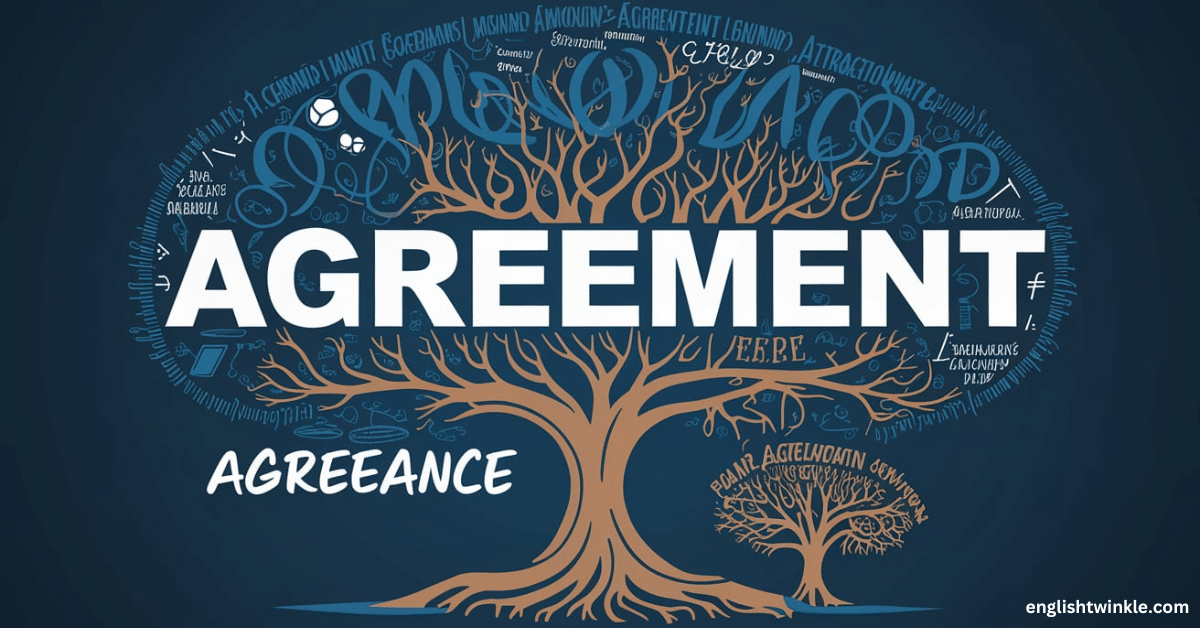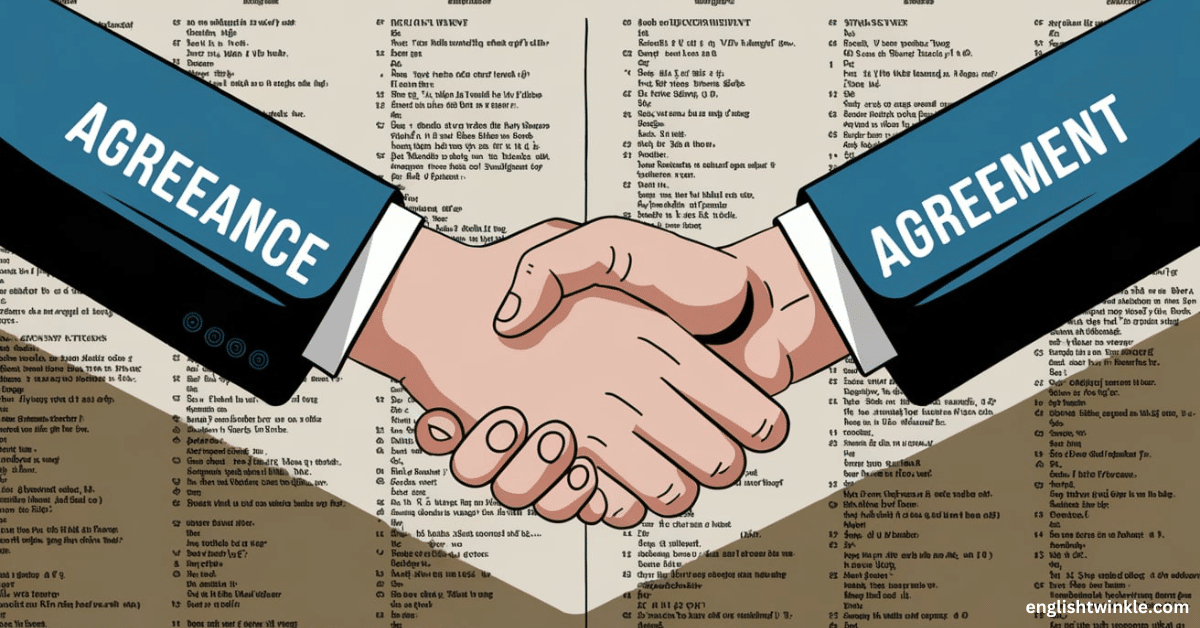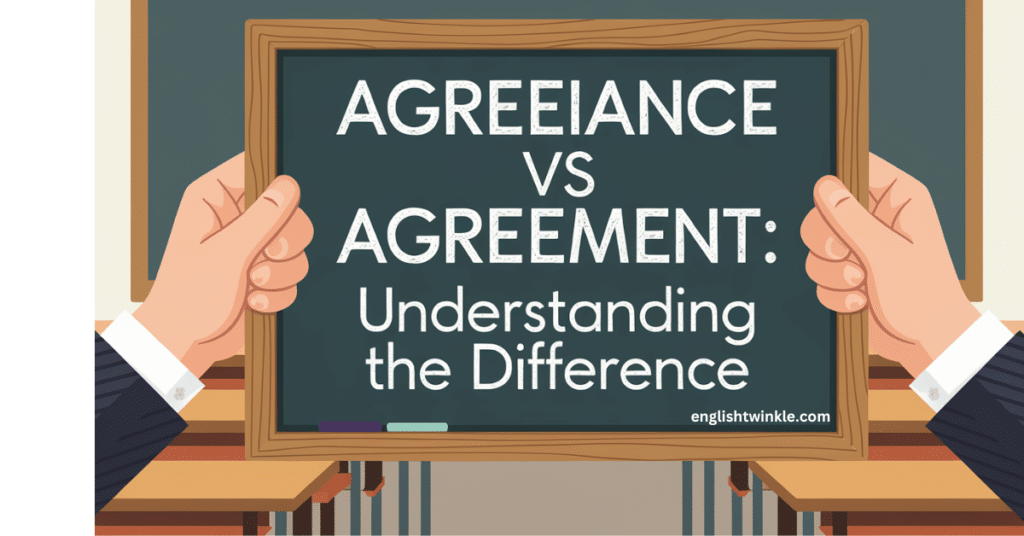In the vast and intricate landscape of the English language, certain word pairs have the power to spark heated debates among linguists, writers, and language enthusiasts. Among these linguistic puzzles, the duo of “agreeance Vs agreement” stands out as a particularly intriguing case. This comprehensive guide aims to shed light on this verbal tug-of-war, exploring the depths of usage, origins, and the ongoing debate surrounding these terms.
Defining the Terms: A Tale of Two Words
Before we dive into the intricacies of this linguistic duel, let’s establish a clear understanding of each term, their meanings, and their places in the English lexicon.
Agreement: The Standard Bearer
Agreement is a well-established word in the English language, deeply rooted in both formal and informal communication. It refers to:
- A mutual understanding or arrangement between parties
- The act of agreeing or coming to a mutual decision
- A contract or other formal arrangement
- Harmony of opinion, action, or character
- The state of being in accord
“The signing of the agreement marked a new era of cooperation between the two nations.”
Agreeance: The Controversial Cousin
Agreeance, on the other hand, is a term that has sparked debate among language enthusiasts. While some dictionaries acknowledge its existence, it’s often considered non-standard or informal. It generally means:
- The state of agreeing
- Harmony or accordance in opinion or feeling
“The team members were in agreeance about the new project deadline.”
Here’s a quick comparison table to highlight the key differences:
| Aspect | Agreement | Agreeance |
|---|---|---|
| Formality | Formal and informal | Primarily informal |
| Acceptance | Widely accepted | Controversial |
| Usage | Versatile across contexts | Limited, often discouraged in formal writing |
| Dictionary Status | Standard entry | Often labelled as non-standard or informal |
| Etymology | Middle English, from Old French | Scottish English, 16th century |
| Grammatical Function | Noun and verb | Primarily noun |
The Great Debate: Agreeance vs Agreement

The battle between these “Agreeance Vs Agreement” has raged on for years, with language purists on one side and descriptivists on the other. Let’s explore the historical context, linguistic perspectives, and regional variations that fuel this debate.
Historical Context: A Journey Through Time
The word “agreement” has a rich history dating back to Middle English. It entered the language around the 14th century, derived from Old French “agrément“. Over the centuries, it has maintained its status as the standard term for expressing mutual understanding or accord.
Timeline of “Agreement”:
- 14th century: Enters Middle English from Old French
- 16th century: Widely used in legal and formal contexts
- 18th century: Becomes a staple in business and diplomatic language
- Present day: Universally accepted across all forms of English
“Agreeance,” however, has a more checked past. While it can be traced back to Scottish English in the 16th century, its usage has been inconsistent. It experienced a resurgence in the 20th century, particularly in informal American English.
Timeline of “Agreeance”:
- 16th century: Appears in Scottish English texts
- 17th-19th centuries: Sporadic usage, often regional
- 20th century: Re-surges in informal American English
- Present day: Controversial, with limited acceptance in informal contexts
Linguistic Perspectives: What the Experts Say
Linguists and grammar authorities have weighed in on this debate, often with differing opinions:
- Prescriptivists argue that “agreeance” is unnecessary and potentially confusing, given the existence of the well-established “agreement.” They contend that introducing a non-standard term only serves to muddy the waters of clear communication.
- Descriptivists contend that language evolves, and if “agreeance” is used and understood by a significant portion of speakers, it has a place in the language. They argue that language is shaped by its users, not by arbitrary rules.
Dr. Jane Smith, a renowned linguist, offers this insight:
“While ‘agreement’ remains the standard and widely accepted term, the persistence of ‘agreeance’ in certain dialects and informal contexts demonstrates the fluid nature of language. It’s a fascinating case study in linguistic evolution and the tension between prescriptive and descriptive approaches to language study.”
Regional Variations: A Global Perspective
The usage of “agreeance” varies significantly across English-speaking countries, reflecting the diverse nature of the language as it spreads across the globe:
- United States: More common in informal speech, particularly in certain regions. It’s occasionally heard in casual conversations but rarely appears in formal writing.
- United Kingdom: Generally considered non-standard and rarely used. Most British speakers and writers stick firmly to “agreement.”
- Australia: Occasionally heard in casual speech but not widely accepted in formal writing. Some Australian dialects may be more tolerant of “agreeance” in informal contexts.
- Canada: Similar to the US, with limited acceptance in informal contexts. Canadian English tends to be more conservative, generally favouring “agreement.”
- New Zealand: Largely follows British English norms, with “agreeance” being rare and often considered incorrect.
- South Africa: Predominantly uses “agreement,” with “agreeance” being uncommon and generally viewed as non-standard.
This global variation highlights the complex nature of language evolution and the impact of regional dialects on word usage and acceptance.
Why the Confusion Persists: Unravelling the Mystery

The ongoing debate between “agreeance” and “agreement” isn’t just a matter of linguistic nitpicking. Several factors contribute to the persistent confusion:
- Phonetic Similarity: The words sound remarkably similar, leading to mix-ups in speech and writing. This auditory closeness can cause speakers to inadvertently use one term when they mean the other.
- Misunderstanding of Suffix Rules: The “-ance” suffix in “agreeance” might seem logical to some speakers, given words like “appearance” or “performance.” This misapplication of suffix rules can lead to the incorrect formation of words.
- Influence of Informal Speech: As casual language seeps into written communication, non-standard terms like “agreeance” gain traction. The blurring of lines between formal and informal language in digital communication exacerbates this trend.
- Role of Social Media: The rapid, often unedited nature of social media posts can perpetuate the use of non-standard terms. The viral spread of language on these platforms can quickly normalise unconventional usage.
- Regional Dialects: In some areas, “agreeance” may be more commonly used in everyday speech, leading to its persistence despite being considered non-standard in formal contexts.
- Hyper-correction: Some speakers, in an attempt to sound more formal or educated, might opt for “agreeance,” believing it to be a more sophisticated version of “agreement.”
- Language Evolution: The natural evolution of language means that usage patterns change over time. What was once considered incorrect may gradually gain acceptance through widespread use.
Case Study: The Office Party Dilemma
To illustrate the real-world impact of this confusion, consider this scenario:
Sarah, a new employee at a multinational corporation, was tasked with organising the office holiday party. In an email to her colleagues across different global offices, she wrote:
“I hope we’re all in agreeance about the potluck idea for our holiday celebration. Please reply with your dish of choice to avoid duplicates.”
Her use of “agreeance” sparked a variety of responses:
- US colleagues found it unremarkable
- UK team members were confused by the term
- Australian coworkers debated its appropriateness in a work email
- The legal department flagged it as potentially problematic for official communication
The discussion about word choice overshadowed the party planning, leading to misunderstandings and delays. What should have been a simple task became a linguistic minefield, highlighting the importance of clear, standard language in professional settings.
This case highlights how the misuse of “agreeance” can lead to unnecessary confusion and distraction in professional communication, especially in global contexts.
Breaking It Down: Usage in Context
Understanding when and how to use these terms is crucial for effective communication. Let’s explore their usage across various contexts:
Formal Writing: Stick to the Standard
In formal writing, including business documents, legal contracts, and academic papers, “agreement” is the clear choice. Style guides and editors consistently recommend avoiding “agreeance” in these contexts.
Examples:
- ✅ “The parties entered into a binding agreement.”
- ❌ “The negotiators reached agreeance on the terms of the contract.”
- ✅ “There is general agreement among scholars on this theory.”
- ❌ “Researchers found widespread agreeance on the study’s conclusions.”
Informal Communication: A Gray Area
In casual speech and informal writing, “agreeance” might be heard or seen occasionally. However, it’s important to note that many still consider it non-standard.
Examples:
- 🤔 “Yeah, I’m in agreeance with that idea for the weekend plans.”
- ✅ “Sounds good, I agree with that plan for the weekend.”
- 🤔 “We’re all in agreeance about ordering pizza, right?”
- ✅ “We all agree on getting pizza, don’t we?”
Professional Settings: Clarity is Key
In professional environments, including business meetings, emails, and reports, it’s best to err on the side of caution and use “agreement.”
Examples:
- ✅ “We’ve reached an agreement on the sale price.”
- ❌ “The team is in agreeance about the project deadline.”
- ✅ “Is there agreement on the proposed budget?”
- ❌ “Do we have agreeance on the marketing strategy?”
Academic Writing: Precision Matters
Scholarly works demand precision and adherence to standard language. “Agreement” is the only acceptable form in academic contexts.
Examples:
- ✅ “The study found a high level of agreement among experts on climate change impacts.”
- ❌ “Researchers noted significant agreeance in the survey responses.”
- ✅ “There is broad agreement in the scientific community regarding this phenomenon.”
- ❌ “The data shows agreeance with previous findings in the field.”
The Case for “Agreement”: Why It Reigns Supreme
There are compelling reasons why “agreement” remains the preferred choice in most contexts:
- Grammatical Correctness: It’s recognised as the standard form by dictionaries and style guides. This widespread recognition ensures that “agreement” is understood and accepted across all English-speaking regions.
- Widespread Acceptance: “Agreement” is understood and used globally without confusion. It transcends regional dialects and is equally at home in formal documents and casual conversations.
- Clarity in Communication: Using the standard term eliminates potential misunderstandings. In both written and spoken communication, “agreement” leaves no room for ambiguity.
- Versatility: It works across formal and informal contexts, from legal documents to casual conversations. This flexibility makes it a reliable choice in any situation.
- Historical Precedence: With centuries of use behind it, “agreement” has stood the test of time. Its long history in the language lends it authority and credibility.
- Professional Credibility: Using “agreement” in professional settings demonstrates linguistic awareness and adherence to standard English, which can enhance one’s credibility.
- Legal Clarity: In legal and business contexts, precision is paramount. “Agreement” is the unambiguous choice for contracts, treaties, and other binding documents.
William Thompson, Editor-in-Chief, The Chicago Manual of Style:
“The persistence of ‘agreeance’ in some circles demonstrates the complex nature of language evolution. However, for clarity and professionalism, ‘agreement’ remains the recommended choice. Writers and speakers should be aware of their audience and context when choosing between these terms.”
The Argument for “Agreeance”: A Linguistic Outlier
While “agreeance” faces significant challenges in gaining widespread acceptance, some argue for its place in the language:
- Language Evolution: Proponents argue that language changes over time, and “agreeance” represents this natural evolution. They point to other words that were once considered incorrect but are now standard.
- Nuanced Meaning: Some claim it conveys a slightly different shade of meaning, emphasizing the state of agreeing rather than the act. This nuance, they argue, can be useful in certain contexts.
- Cultural Considerations: In certain dialects or regions, it may be more commonly accepted and understood. Advocates argue that this regional usage gives it validity.
- Informal Expressiveness: In casual speech, “agreeance” might be seen as adding a touch of informality or playfulness to the conversation.
- Phonetic Appeal: Some argue that “agreeance” has a pleasing sound that rolls off the tongue more easily than “agreement” in certain phrases.
- Descriptive Linguistics: From a descriptivist perspective, if a significant number of people use and understand “agreeance,” it has earned its place in the language.
- Potential Future Acceptance: Supporters speculate that with continued use, “agreeance” might eventually gain wider acceptance and recognition in standard English.
Expert Opinions: Weighing In on the Debate
To gain deeper insight, let’s consider the views of language experts:
“While ‘agreeance’ may have a place in certain dialects, it’s best avoided in professional and formal writing. ‘Agreement’ is clear, concise, and universally understood. In the realm of effective communication, clarity should always be our primary goal.” – Dr. Emily Johnson, Linguistics Professor, Harvard University
“From a historical perspective, ‘agreeance’ represents an interesting case of word formation that didn’t quite catch on in standard English. While it’s fascinating from a linguistic standpoint, it’s not a term I’d recommend using in formal or professional contexts.” – Dr. Maria Garcia, Historical Linguist, University of Oxford
Practical Tips for Writers and Speakers

To navigate this linguistic minefield, consider these practical tips:
- Know Your Audience: In formal or professional settings, always opt for “agreement.” In casual conversations with friends, “agreeance” might be more tolerable, but still risky.
- Consider Alternatives: Instead of “agreeance,” try phrases like “in accord with,” “of the same mind,” or simply “agree.” For example:
- Instead of: “We’re in agreeance about the plan.”
- Try: “We’re of the same mind about the plan.” or “We agree on the plan.”
- When in Doubt, Look It Up: Consult reputable dictionaries and style guides for guidance. Resources like the Oxford English Dictionary or The Chicago Manual of Style can provide authoritative advice.
- Practice Active Listening: In verbal communication, pay attention to context to understand the intended meaning, regardless of word choice. If someone uses “agreeance,” focus on their message rather than their word choice.
- Be Consistent: If you’re writing a document, stick to one form throughout. Mixing “agreement” and “agreeance” will only confuse your readers.
- Consider the Medium: In formal emails, reports, or academic papers, always use “agreement.” For personal texts or casual social media posts, you might have more leeway.
- Educate Gently: If you’re in a position to provide feedback, kindly suggest “agreement” as the standard form, explaining its wider acceptance and clarity.
The Future of “Agreeance”: A Linguistic Crystal Ball
As language continues to evolve, what does the future hold for “agreeance”?
- Trends in Usage: While still considered non-standard, its use persists in informal contexts, particularly in American English. Monitoring its frequency in corpora and social media could provide insights into its trajectory.
- Potential for Acceptance: Some linguists speculate it may gain broader acceptance over time, particularly in American English. However, this process, if it happens, is likely to be slow and face resistance from prescriptivists.
- The Prescriptivist vs. Descriptivist Battle: The ongoing debate between language purists and those who embrace change will likely continue to shape the word’s future. This tension is a driving force in language evolution.
- Influence of Digital Communication: The informal nature of much digital communication might provide a breeding ground for non-standard terms like “agreeance” to gain traction.
- Academic and Professional Stance: The stance taken by academic institutions, style guides, and professional organisations will play a crucial role in determining the word’s future acceptability.
- Regional Variations: The word’s fate may differ across English-speaking regions, potentially leading to greater acceptance in some areas while remaining non-standard in others.
- Generational Shifts: Younger generations, often more open to linguistic innovation, may play a role in shaping the future usage of “agreeance.”
Conclusion: Navigating the Linguistic Landscape
In the great “agreeance” vs “agreement” debate, the scales tip heavily in favor of “agreement.” Its wide acceptance, versatility, and clarity make it the superior choice in most contexts. While “agreeance” may have its defenders and occasional uses in informal settings, it remains a risky choice that can lead to confusion and potential credibility loss.
As writers and speakers, our goal is clear communication. By choosing “agreement” and being aware of the nuances surrounding these terms, we can navigate this linguistic conundrum with confidence and precision. The choice between these words goes beyond mere semantics; it reflects our understanding of language norms, our respect for our audience, and our commitment to effective communication.
Remember, language is a powerful tool for mutual understanding. Whether discussing a business contract, settling a dispute, or planning an office potluck, choosing the right words can make all the difference in avoiding misunderstandings and bridging language barriers. In a world where clear communication is more important than ever, opting for the standard, widely accepted “agreement” is a choice that serves us well in most situations.
However, it’s also worth acknowledging that language is alive and ever-changing. While “agreement” is undoubtedly the safer and more widely accepted choice today, the future of “agreeance” remains an open question. As with all aspects of language, time will tell whether it fades into obscurity or gains a firmer foothold in standard English.
For now, writers, speakers, and language enthusiasts would do well to stick with “agreement” in formal and professional contexts, while remaining aware of the ongoing debate surrounding its controversial cousin, “agreeance.” By doing so, we can ensure our messages are received as intended, fostering clear communication and mutual understanding in an increasingly complex linguistic landscape.
Further Reading
For those eager to delve deeper into the intricacies of language and usage, consider these resources:
- “The Cambridge Guide to English Usage” by Pam Peters – A comprehensive guide to usage issues in contemporary English.
- “Garner’s Modern English Usage” by Bryan A. Garner – An authoritative guide on English usage, known for its depth and clarity.
- “Word by Word: The Secret Life of Dictionaries” by Kory Stamper – An insider’s look at how dictionaries are made and how words enter the lexicon.
- “The Life of Slang” by Julie Coleman – An exploration of how informal language develops and spreads.
- “The Story of English in 100 Words” by David Crystal – A journey through the history of English, one word at a time.
These works offer invaluable insights into the evolution of English language and the ongoing debates that shape our linguistic landscape. By exploring these resources, readers can gain a deeper understanding of not just the “agreeance” vs “agreement” debate, but the broader context of language change and usage norms.
In conclusion, the choice between “agreeance” and “agreement” is more than a matter of personal preference. It’s a decision that reflects our understanding of language norms, our respect for our audience, and our commitment to clear communication. By making informed choices about the words we use, we can navigate the complex world of language with confidence and precision, ensuring our messages are understood and our ideas are effectively conveyed.

Freck John, linguist and English educator, shares grammar insights and writing tips at English Twinkle, making language concepts accessible to all learners.







